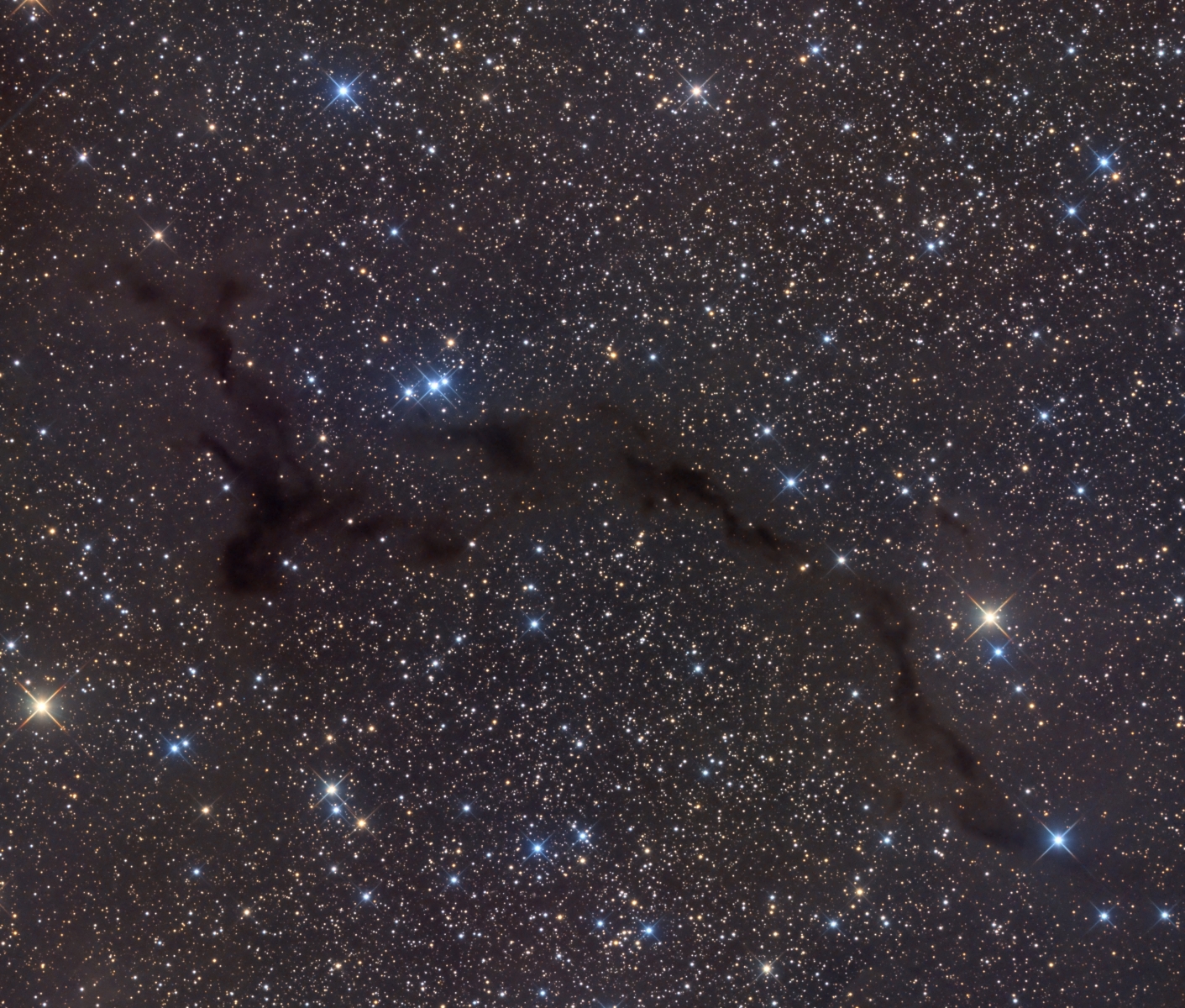Barnard 150, Dark Nebula
 Click image for full size version
Click image for full size version
October 10, 2016, Chinese National Astronomy Magazine, Dec. 2016
 Barnard 150 is a dark nebula in the constellation Cepheus. It is about one degree long (about two Moon widths). It’s sometimes referred to as the Seahorse nebula – you may see its namesake better if you rotate the image 90 degrees clockwise (or tilt your head left). The nebula is made up of soot and dust within our galaxy. It appears dark because it is blocking out the light of stars behind it. The rich star field in which this object is set displays stars of many hues, which depend on their temperatures (blue and white are hotter; yellow and reddish are cooler).
Barnard 150 is a dark nebula in the constellation Cepheus. It is about one degree long (about two Moon widths). It’s sometimes referred to as the Seahorse nebula – you may see its namesake better if you rotate the image 90 degrees clockwise (or tilt your head left). The nebula is made up of soot and dust within our galaxy. It appears dark because it is blocking out the light of stars behind it. The rich star field in which this object is set displays stars of many hues, which depend on their temperatures (blue and white are hotter; yellow and reddish are cooler).
Tekkies
Moravian G3-16200 EC camera (on loan from O’Telescope), Optolong RGB filters, 10″ f/3.6 ASA astrograph, Paramount MX, QHY5 guide camera through Lumicon 500 mm f.l. achromat. Acquisition with the SkyX, Focusing with FocusMax. All pre-processing and processing in PixInsight. Acquired from my SkyShed in Guelph. Nearly full moon, no cloud, average transparency and average seeing.
18x10m R, 18x10m G and 18x10m B unbinned frames (total=9hr).
RGB
Creation and cleanup: R, G and B masters were cropped and processed separately with DBE. R, G and B were combined to make an RGB image which was processed with ColorCalibration.
Linear Noise Reduction: MultiscaleLinearTransform was used to reduce noise in the background areas. Layer settings for threshold and strength: Layer 1: 3.0, 0.5 Layer 2: 2.0, 0.35 Layer 3: 1.0, 0.2 Layer 4: 0.5, 0.1
Stretching: HistogramTransformation was applied to make a pleasing yet bright image. TGVDenoise was applied and the image was re-stretched to reset the black point.
Synthetic Luminance:
Creation and cleanup of SynthL: The cleaned up R,G and B masters were combined using the ImageIntegration tool (average, additive with scaling, noise evaluation, iterative K-sigma / biweight midvariance, no pixel rejection).
Linear Noise Reduction: MultiscaleLinearTransform was applied to reduce the noise. Layer settings for threshold and strength: Layer 1: 3.0, 0.5 Layer 2: 2.0, 0.35 Layer 3: 1.0, 0.2 Layer 4: 0.5, 0.1
Stretching: HistogramTransformation was applied to make a pleasing yet bright image. TGVDenoise was applied and the image was re-stretched to reset the black point.
Combining SynthL with RGB:
The luminance channel of the RGB image was extracted, processed and then added back into the RGB image as follows:
1. Extract luminance from the RGB image.
2. Apply LinearFit using SynthL as the reference.
3. Use ChannelCombination in Lab mode to replace the RGB’s luminance with the fitted luminance from step 2.
4. LRGBCombine was then used to make a SynthLRGB image.
Final Processing of SynthLRGB:
Background and star brightness, contrast and saturation were adjusted in several iterations using Curves with masks as required.
Image scale is 1.36 arcsec per pixel for this camera / telescope combination.






Beautiful photo.